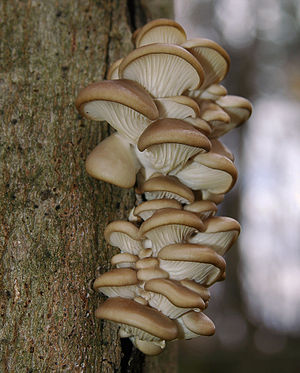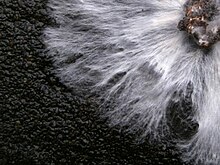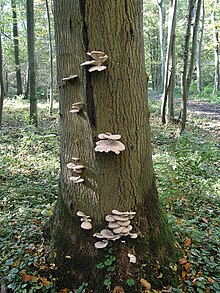Oyster mushroom
| Oyster mushroom | ||||||||||||
|---|---|---|---|---|---|---|---|---|---|---|---|---|

A cluster of young fruiting bodies of the oyster mushroom ( Pleurotus ostreatus ) |
||||||||||||
| Systematics | ||||||||||||
|
||||||||||||
| Scientific name | ||||||||||||
| Pleurotus ostreatus | ||||||||||||
| ( Jacq .: Fr. ) P. Kumm. |
The oyster mushroom or oyster mushroom ( Pleurotus ostreatus ) is a type of mushroom from the family of the mushroom relatives .
features
Cultivated fruit bodies offered in the trade can show an appearance that differs from wild forms.
The oyster mushroom usually appears in dense clusters on the substrate . The individual fruiting bodies initially have a tongue-like to spatula-shaped shape and later a shell-like to semicircular habit .
The stem is 1–4 cm long, 1–3 cm wide and usually sits on the side of the hat. It can also only be rudimentary. The surface is finely felted, with a shaggy structure on the base.
The hat can reach a diameter of 5–25 cm. Young specimens have rolled-up edges that tear limp with age. The hat skin is smooth, glabrous and shiny, sometimes fibrous and dry. The color spectrum ranges from blue-gray, slate to black-gray and dark brown to olive-brown.
The lamellae on the underside are whitish and crowded. They clearly run down the stem and branch out like a mesh. The spore powder released in abundance is white.
The meat is also white, rarely brownish, has a soft consistency when young and has a pleasant smell. With age it quickly becomes tough and then smells musty.
ecology
The oyster mushroom is a saprobiont or weak parasite mainly on hardwood, less often on coniferous wood. In Germany he predominantly chooses the common beech as substrate. The fungus usually colonizes the trunk wood and thicker branches - the fruiting bodies can appear several meters above the ground on standing trees. In culture, oyster mushrooms grow on various substrates such as straw, paper, coffee grounds, the pulp of coffee beans and wheat grains.
Central European oyster mushroom strains only fructify at low temperatures; Bresinsky found that temperatures below 11 ° C are necessary to trigger their development. The fruit bodies can survive periods of frost and sporulate even at temperatures below freezing (according to Bresinsky down to −2.8 ° C). Accordingly, the species is a "winter mushroom" in Central Europe.
In culture, Florida- derived forms are identified as cv. "Florida"; these forms are not dependent on the cold stimulus for fructification, they are lighter than the Central European wild form.
Nematophagous mushroom
The oyster mushroom is nematophagous . He is able to poison nematodes with the help of toxocysts . Fungal hyphae invade the paralyzed or killed elk, which are then digested.
Species delimitation
The oyster mushroom in its typical shape is relatively easy to recognize. However, it can be particularly difficult to distinguish whitish summer forms of oyster mushrooms from other edible representatives of the genus mushrooms ( Pleurotus ).
- Specimens that grow without the influence of frost can look very similar to the pulmonary mushroom ( Pleurotus pulmonarius ). This is pearly white to gray or brownish in color, but always without any blue tones. It is thinner and often smells pleasantly sweet like aniseed . Its stem base is finely felted, not shaggy like the oyster mushroom. His hat often turns yellow with age, but oyster mushrooms can also turn yellow. The lung mushroom grows only in the summer months.
- The Rillstielige Seitling ( Pleurotus cornucopiae ) has more curled up fruiting bodies with a longer, more central stem and deeply sloping, anastomosing lamellae.
- The Berindete Seitling ( Pleurotus dryinus ) differs in its velum .
- The inedible yellow- stemmed oyster mushroom ( Sarcomyxa serotina ) has a detached, yellow stem with brown scales and an olive-green tint on the surface of the hat.
- The potentially highly poisonous ear-shaped white oyster mushroom ( Pleurocybella porrigens ) only grows on softwood; it forms translucent, glassy white, young, cone-shaped fruit bodies without a stem, the lamellae of which converge at the point of growth.
- The inedible clump of hardwood ( Panus conchatus ) has tough flesh and a distinct purple tint when young, which fades with age.
distribution
The oyster mushroom can be found almost everywhere in the world.
meaning
cultivation

Oyster mushrooms are popular edible mushrooms and are cultivated in large quantities . They come on the market as a veal mushroom (and under other fantasy names). Wood and straw are mainly used as substrates, but other agricultural waste and by-products can also be used for cultivation. Optimal culture conditions are indicated differently, e.g. B. on a substrate made of sterilized sawdust under weak lighting, a constant temperature between 16 and 18 ° C and a constant humidity of 83 to 85%.
The oyster mushroom, along with the cultivated mushrooms and the shiitake, is one of the three most important cultivated mushrooms in the world and should take first place among these in terms of harvest volume. For 2005/2006 an annual harvest of 2.5 million tonnes was given worldwide, for 2008 in Germany 500. When cultivated in closed rooms, the abundant spores released can cause health problems because inhaled they can trigger allergic reactions.
Remedies
In the tradition of different cultures, different mushrooms are used as possible remedies, often in dried form. In terms of diet, they serve a low-fat, high-fiber diet and also offer a variety of special ingredients such as trace elements , mycosterols , special polysaccharides or specific enzymatically active proteins. For Pleurotus ostreatus , for example, there is evidence of a preventive effect with regard to chemically induced forms of colon cancer.
swell
literature
- A. Bresinsky : Snow cap mushrooms - oyster mushrooms. In: The Tintling . 4/2006, pages 8-18, ISSN 1430-595X
- Josef Breitenbach, Fred Kränzlin (Ed.): Mushrooms of Switzerland. Contribution to knowledge of the fungal flora in Switzerland. Volume 3: Bolete and agaric mushrooms. Part 1: Strobilomycetaceae and Boletaceae, Paxillaceae, Gomphidiacea, Hygrophoracea, Tricholomataceae, Polyporaceae (lamellar). Mykologia, Luzern 1991, ISBN 3-85604-030-7 .
- German Josef Krieglsteiner (Ed.), Andreas Gminder : Die Großpilze Baden-Württemberg . Volume 3: Mushrooms. Leaf mushrooms I. Ulmer, Stuttgart 2001, ISBN 3-8001-3536-1 .
- P. Stamets, Growing Gourmet and Medicinical Mushrooms Third Edition, Ten Speed Press, Berkeley - Toronto, ISBN 978-1-58008-175-7 , 2000
Individual evidence
- ^ R. Greg Thorn, George, L. Barron: Carnivorous mushrooms . In: Science . tape 224 , no. 4644 , 1984, pp. 76-78 , doi : 10.1126 / science.224.4644.76 .
- ↑ Kulturpilz.de
- ^ Landesbetrieb Landwirtschaft Hessen, Bund Deutscher Champignon- und Kulturpilzanbauer (BDC) eV
- ↑ Cox, A., HT Folgering, and LJ Van Griensven: Extrinsic allergic alveolitis caused by spores of the oyster mushroom Pleurotus ostreatus. European Respiratory Journal, Volume 1, Number 5, 1988, pp. 466-468 .
- ↑ Daba, Ayman S. et al .: Production of mushroom (Pleurotus ostreatus) in Egypt as a source of nutritional and medicinal food. World Journal of Agricultural Sciences, Volume 4, Number 5, 2008, pp. 630-634 (PDF; 175 kB) .
- ↑ P. Bobek, S. Galbavy, L. Ozdin: Effect of oyster mushroom (Pleurotus ostreatus) on pathological changes in dimethylhydrazine-induced rat colon cancer. Oncology Reports. 1998, May-Jun; 5 (3), pp. 727-30. PMID 9538185


